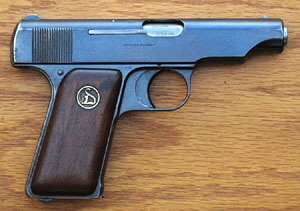Deutsche Werke Ortgies Serial Numbers

German ortgies semiauto pistol 7.65mm.32 acorn serial #1074. On the left side of the slide it reads Deutsche Werke the a circle with a D and then Werk Erfurt. Hello I have a Ortgies& co Erfurt 7.65 **** grip medallion serial number 1644. Nov 03, 2012 Can anyone tell me a date for a ortgies.32 stamped Germany (import model) S# 1500XX? 5,354 Location: Goodyear, Arizona. Only that it was made in the 1930's and imported in large numbers. There is no serial number base for these well made but ill designed firearms. Ortgies (Deutsche Werke) Gun Digest.doc File size: 1.4 MB Views: 284.
Cctalk serial interface download. 4.1 24-05-01 Modification to recommended ccTalk interface circuit ‘Circuit 1 - ccTalk Standard Interface’ 4.2 05-10-01 Addition of connector type 9 for serial universal hopper. CcTalk tutorial, the hardware interface. Posted on August 11, 2015 February 6, 2018 by ccTalk tutorial The logic levels for the ccTalk line are 3.5 to 5V for mark state (idle ) and 0 to 1V for space state (active).
LSB#: 130502MR02 Make: Deutsche Werke Model: Ortgies -.32 ACP Serial Number: 181677 Year of Manufacture: 1919-1921 Caliber:.32 ACP (7.65mm Browning) Action Type: Single Action Semi-Automatic Pistol with Removable Magazine Markings: The left side of the slide is marked “Deutsche Werke”, a logo, and “Werk Erfurt.” The right side of the slide is marked “Ortgies’ Patent”. The top of the slide and the right side of the frame both have a Crowned “N” proof. The bottom of the frame in front of the trigger guard is marked “181677 / Germany”. The barrel is marked with a Crowned “N” proof and “Cal 7.65m/m”. Barrel Length: 3 3/8” Sights / Optics: The front sight is a short blade fixed to the slide. The rear sight is a “U” notch in the base formed on the back of the slide. Stock Configuration & Condition: The grips are smooth walnut with a bronze medallion on each grip.
The medallions show a dragon with a long tail shaped in the form of a “D”. The grips show handling marks and light oil staining. There are small sharp compression marks on the right grip with surface loss above the medallion and one or two compression marks on the left grip. The grips rate in about Very Good overall condition. Type of Finish: Blue Finish Originality: All Original Bore Condition: The bore is bright and the rifling is deep.
There is no erosion in the bore. Overall Condition: This handgun retains about 80-85% of its metal finish. The front of the slide at the muzzle and the top, bottom and back edges of the slide show some surface loss. The slide also shows spots of surface loss around the port opening and on the top and right sides. The extractor shows surface loss.
The bottom corner of the backstrap shows thinning, and the backstrap and front strap show light compression marks. There is light pinprick surface erosion on top edges of the slide with spots on the right side of the slide, and right side of frame behind the trigger. The sides of the trigger guard, the safety and the magazine release show thinning.
The markings are clear. Overall, this handgun rates in about Fine condition.

Mechanics: The action functions correctly. We did not fire this handgun. See Assessment for operation of safety. Box, Paperwork & Accessories: This pistol comes with one 7 round magazine.
It is marked with the Deutsche Werke logo and “Cal. 7,65” on the floorplate.
The magazine shows minimal wear, and is in about Excellent condition. Our Assessment: From Wikipedia: “The pistol was produced in 6.35 mm, 7.65 mm, and 9 mm variants. Although not expensive, at the time it was of advanced design and high quality construction with relatively few parts, well sealed against dirt. Metal components were forged or machined, and assembly in general made no use of screws, even securing the wooden grips with metal clips. The hammerless action depended on a spring-loaded striker to fire the cartridge.
Unusual design features included the safety and the multi-caliber magazine. The safety was a lever inset into the back of the grip and, with the gun cocked, forced backward out of the grip into the 'safe' position by spring tension from the firing pin upon depression of a button under the slide. Thus, engaging the safety simultaneously reduced tension on the firing pin spring. To disengage the safety, a shooter simply would squeeze the grip, pressing the lever forward and locking it flush with the back of the pistol. The Ortgies was a well-balanced, sturdy weapon that found considerable favor in competitive shooting.
In 1921, prize winners at some 70% of principal shooting competitions had chosen Ortgies 7.65 mm pistols, and the winner of the German championship on September 26, 1921, at Halensee, Germany, took the prize firing an Ortgies. At the other end of the user spectrum, outlaw John Dillinger carried an Ortgies.” This is a uniquely made pistol that is in great condition for its age and from its history would appear to be a very accurate little pistol. This pistol should be of interest to collectors, although there were quite a few brought into the US back in the 1920s.